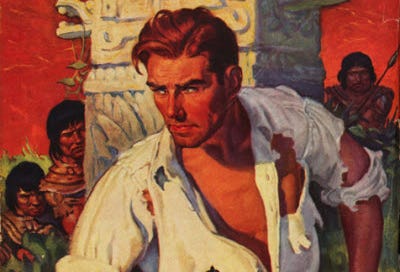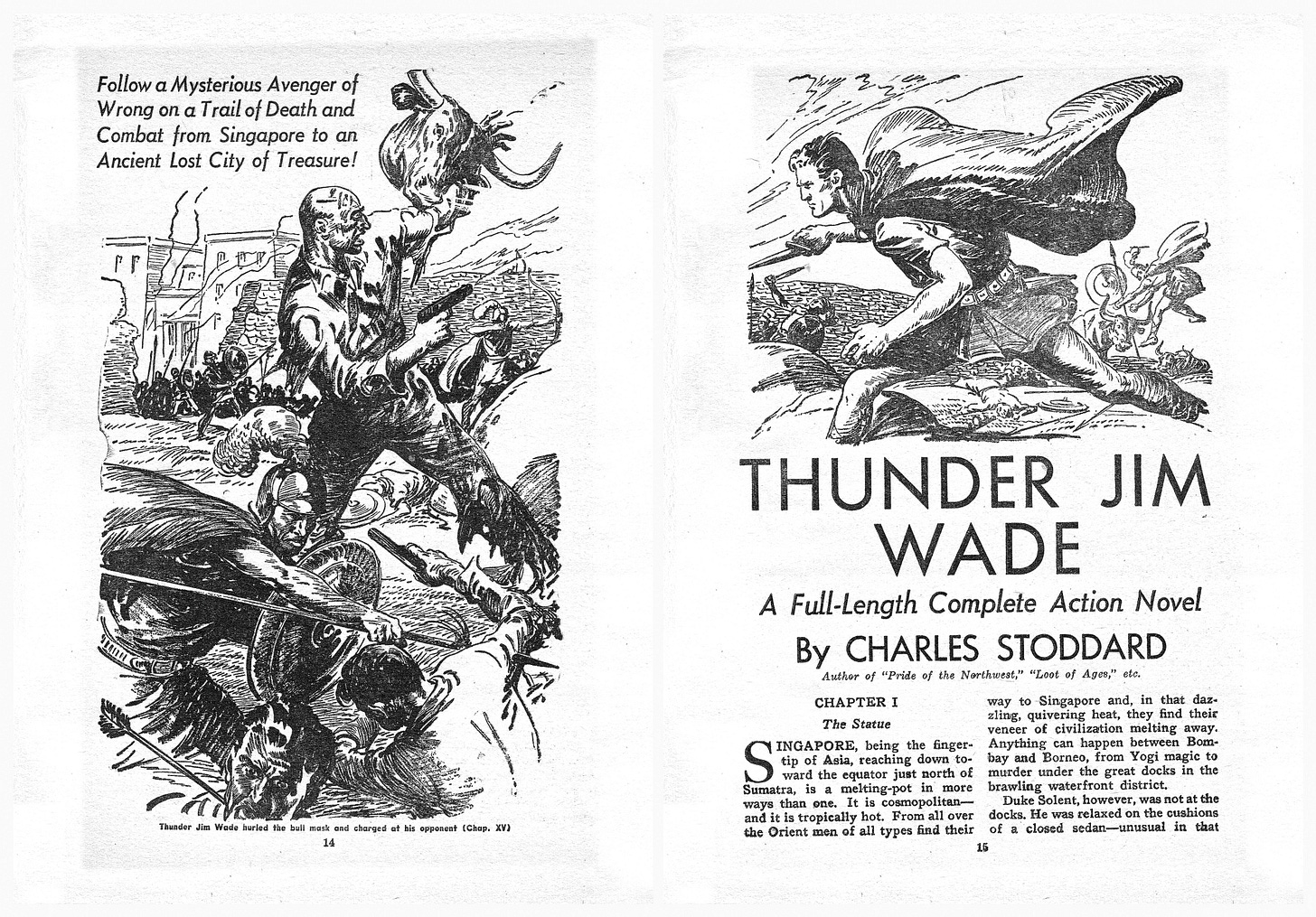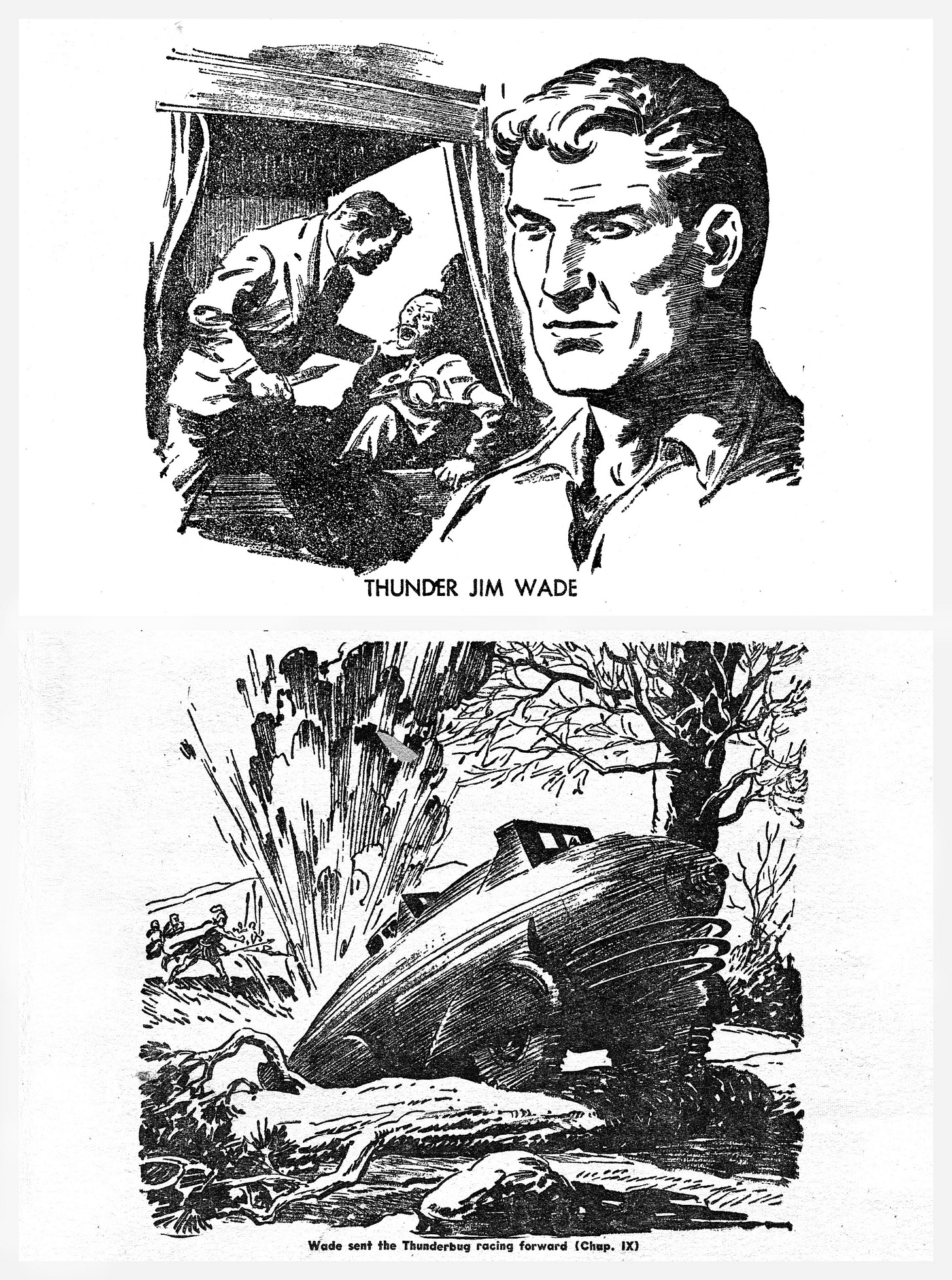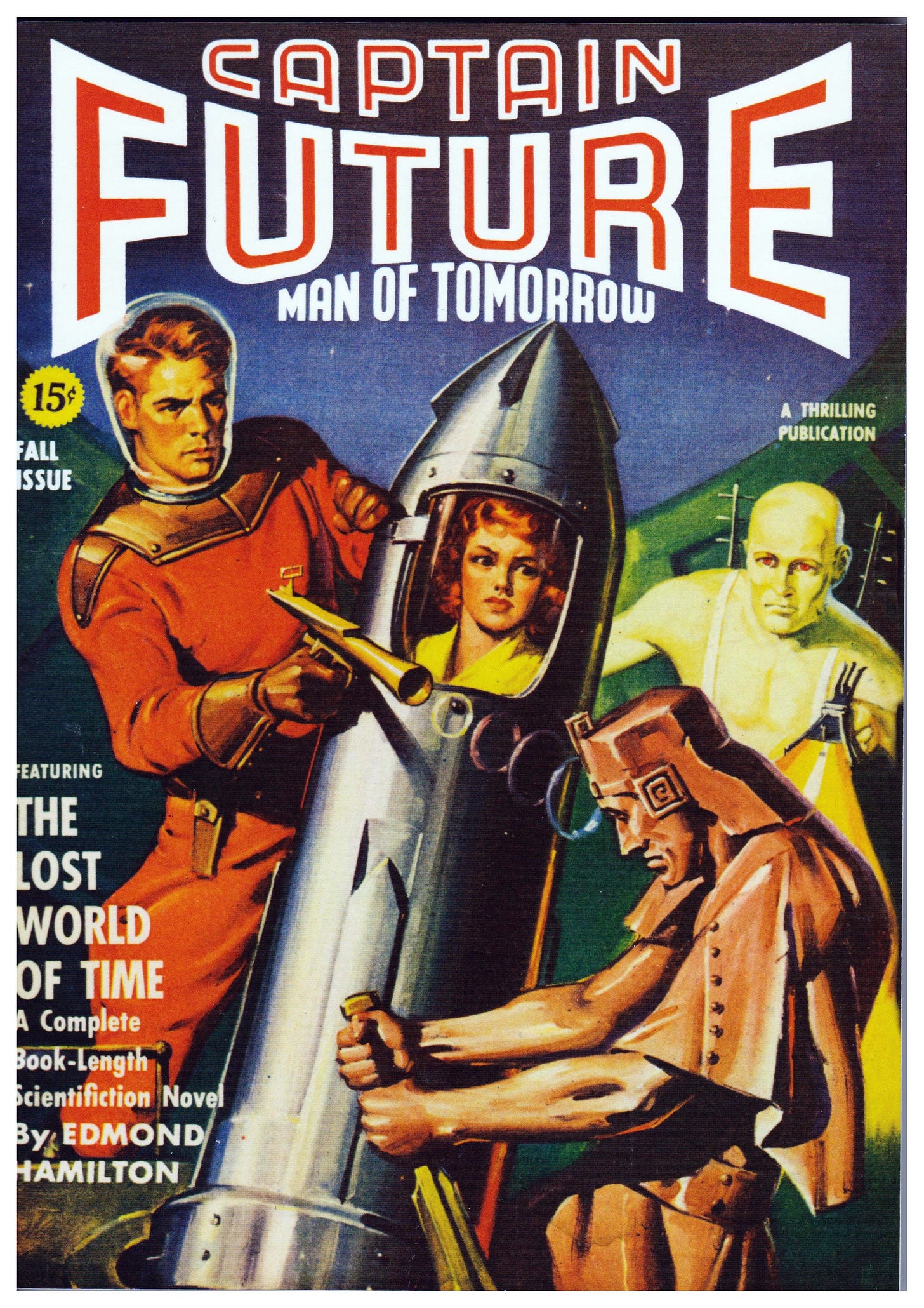It would be an unusual pulp fan who did not know of Doc Savage, Man of Bronze. After making his debut in the self-titled pulp magazine in March of 1933, “Doc” quickly became a fan favorite. Even after ninety years he remains popular with new stories being penned by excellent contemporary pulp writers. I thought it about time to take a look at this pulp juggernaut and some of the other pulp-era characters inspired by him.
Doc Savage was written by Lester Dent (1904–1959) but the stories were published under the house name of Kenneth Robeson. The character was originally conceived as a cross between Tarzan and Sherlock Holmes. He is considered by many to be the first superhero. From what I gather there were slightly under two hundred Doc Savage novels and novellas published between 1933 and 1949.
Doc was raised to be the perfect man. A skilled surgeon and master of many other scientific disciplines, he was also trained to physical perfection. He was called the “Man of Bronze” because of his sun-bronzed skin and similarly-colored hair. When his father is murdered, Doc dedicates his life to punishing evil. He is joined in this lofty mission by five close associates—dapper Harvard lawyer Ham Brooks, engineer Renny Renwick, archaeologist Johnny Littlejohn, electrical expert Long Tom and ape-like but brilliant chemical genius, Monk. Also joining them is Pat Savage, Doc’s red-headed cousin, who carries a Colt .45 in her purse and has a smile that can stop a man dead in his tracks.
In each story, the heroic group travels to exotic locations and does battle with a variety of criminals and villains. They go up against evil dictators, master criminals, mad scientists, and ruthless killers to name just a few. The villains reflect the time of the story therefore during World War II Doc Savage fought Nazis. After the war, communist spies. He’s based out of New York City, with a headquarters on the 86th floor of an unnamed skyscraper (assumed by some fans to be the Empire State Building).
Doc carries an assortment of gadgets: pellets filled with knockout gas, oxygen pills, and miniature bombs. His friends are armed with specially-designed submachine guns that fire different types of ammunition, including “mercy” bullets which only knock people out. Story plots often use science fiction-influenced devices such rays to disintegrate metal. Doc Savage’s adventures are fast-paced and exciting.
In volume 6 of Yesterday’s Faces, pulp historian Robert Sampson talks about why Doc Savage is so inspiring for readers, especially boys and men.
“Doc Savage is what every boy expected to be. And for the boys who had grown into men and disappointed themselves, Doc was the Shining Almost, the What Could Have Been, the gleaming being they felt inside. Only to have done a couple of things differently. You feel the possibility still within reach. Almost you can stretch out your hand, almost grope back the confusions of your life to the turn you missed. Once found, to enter a world more warmly lighted in which success, admiration, excitement, effortless mastery is yours. As you always knew it would be.”
As a woman I can only speculate on what men think about. I suspect that many men (then as now) want to relate to a powerful male figure. Quoting from Sampson again: “Doc Savage, himself…being in equal proportions, wish fulfillment and mythic figure. Tall, sun bronzed, powerful. relentlessly intelligent, he is a physician, surgeon, master of a battery of scientific and engineering disciplines, a supreme athlete, a millionaire philanthropist, and executive. His reputation is international; his peers revere him. He can fight, fly, and speak thirty languages, and if his perfection is a dream beyond reach, it is one worth aspiring to. Even if requiring daily exercise and study.…Doc Savage gave them [readers] a figure to admire and identify with. He is the sublime man….What ultimately drew generations of adolescent boys and shapeless men to Doc Savage was not his intelligence or wealth, but the fabulous wonder of his physical strength…his strength is simply inhuman. He lifts immense weights, tears apart chains, flings men about like balsa wood chips, carries people from danger, leaps shocking distances, runs all night, whips small armies….it is no wonder that the Bronze Man’s most direct descendent is Superman.”
Plus, he had his own Fortress of Solitude in the artic. Seriously.
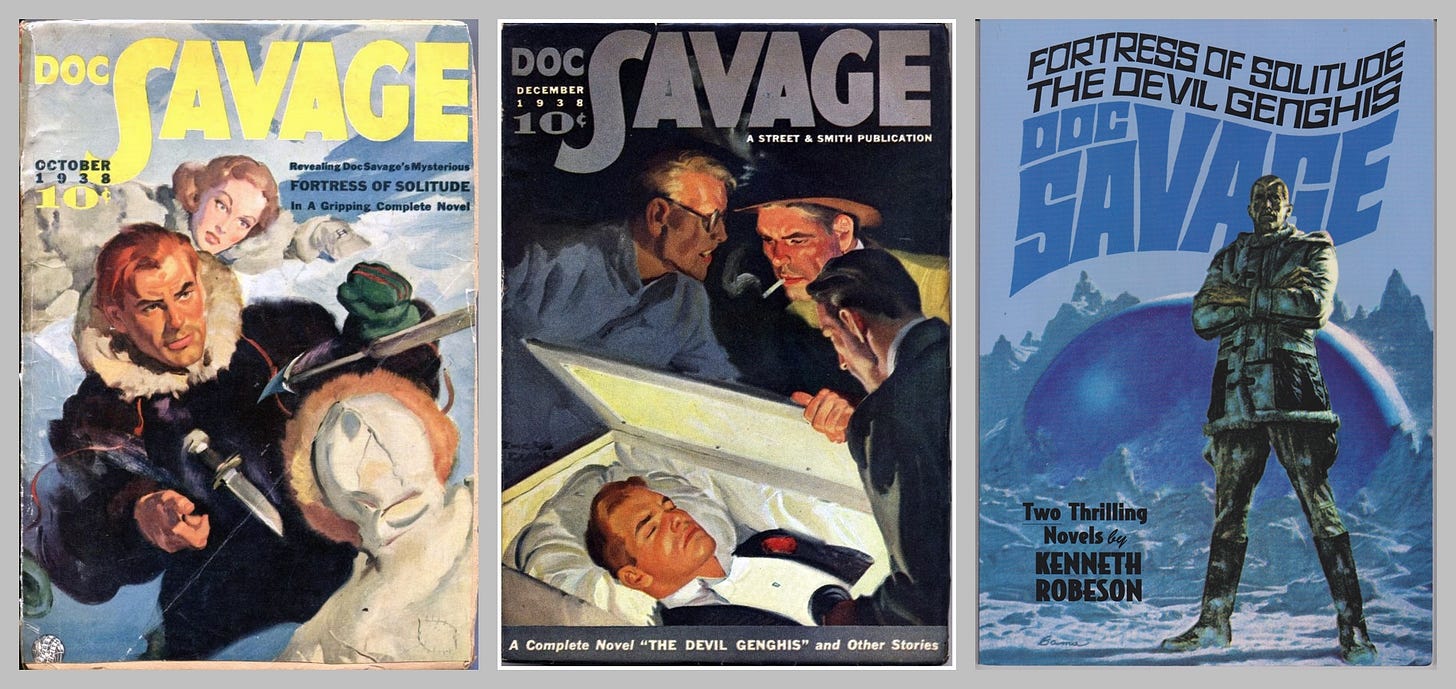
There were quite a few Doc Savage knock-offs during the pulp era including “Secret Agent X” (1934-39), “Captain Hazzard” (1938), “The Avenger” (1939-42), and “Jim Anthony” (1940-43). My personal favorites are “Thunder Jim Wade” (1941) and “Captain Future” (1940-51).
The short-lived Thunder Jim Wade series consisted of five stories written by Henry Kuttner under the Charles Stoddard pseudonym. Thunder Jim Wade was raised by a lost colony from ancient Crete relocated to Africa. He is the beneficiary of their ancient super science, including access to samples of their super-strong metal. He uses this useful metal to create the Thunderbug—part-tank, part-plane, and part-submarine. (The Thunderbug is very cool.) He operates out of a South Pacific island and is aided by two close associates, “Red” Argyle and “Dirk” Marat. Together they travel to exotic locations to right wrongs and punish evil doers.
The original twenty-seven Captain Future stories (mostly written by Edmond Hamilton) were about a super-scientist space hero. He was very popular and remains so to this day. Captain Future gained world-wide fame through a popular Japanese anime in the late 1970’s. Contemporary Captain Future stories have been published recently, bringing his adventures up-to-date. The space hero’s exploits began in his own pulp magazine which ran from 1940 through 1944. Thereafter, Captain Future stories could be found in Startling Stories magazine.
His given name was Curtis Newton. His father was a super-scientist on Earth of the future. Newton runs afoul of a man who eventually murders him and his wife. Curtis is born on the Moon at his father’s secret base and is raised by a trio of strange companions including a “synthetic man” named Otho, a sizeable metal robot named Grag, and his father’s friend, Simon Wright. Wright was dying of an incurable disease and when his body failed he decided to preserve his brain. When Curt knows him, Simon Wright exists as a disembodied brain in a “serum case.” Brilliant scientist Wright teaches young Curt to hone his mind to a razor sharp edge. Curt becomes a scientific genius, outstripping his mentor. He’s also is a highly trained athlete, similar to Doc Savage. He’s also aces with an atom pistol!
As a teen and young adult Curt’s adventurous soul becomes apparent to him. Also, his love of justice. He takes up the nom de guerre of Captain Future and the cause of fighting interplanetary evils. He works closely with the Earth’s president and the Space Patrol, notably Marshal Ezra Gurney. He’s in love with beautiful and competent space patrol agent, Joan Randall. Captain Future’s adventures take him all over the solar system and to other galaxies. He even travels in time once or twice.
The Captain Future stories may be similar in shape and form to Doc Savage, but I like them better. Perhaps it’s because I’m a gal who loves the idea of pulp-era space travel, especially in a ship as cool as Future’s “Comet.” After all, this communiqué is called the Rocketeer!
And speaking of that Space Explorers, this is the Rocketeer signing off for today.


